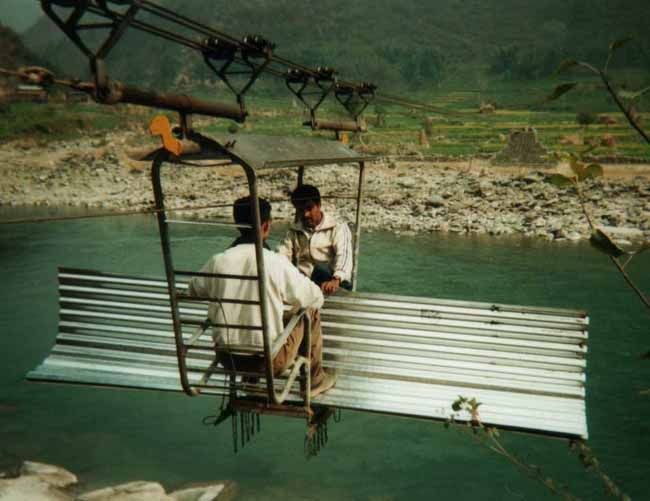Building Bridges in Nepal
The program advertised:
>EcoSystems was started in 1996 by Bay Area expatriates David and Haydi
Sowerwine.
>The company works to improve the welfare of Nepal's rural people by offering
transport
>and energy systems that are safe, efficient, inexpensive, and environmentally
sound.
>To date, EcoSystems has successfully installed 27 WireBridges throughout
Nepal,
>and is nearing completion of the WireRoad, an innovative transportation
system that
>utilizes banana farm cableway technology to transport people and
cargo.
>
>David and Haydi won the
Accenture
Economic Development Award last year.
>The award recognizes innovators who use technology to improve people's
lives.
>David will describe his experiences starting EcoSystems and working with
the
>people of Nepal to improve their lives.
>
David began his talk by explaining that he had worked with Dole in the
Central American banana plantations, so he was aware of what could be done
for rural transport with overhead wire instead of paving from that point
of view. He had originally gone to Nepal to help build 'agribusiness'
and noted that they could be interested in developing cableway
transport instead of paved roads. However, when he got there they looked
at what he brought to the party and asked "Can you please build bridges with
this technology?"
He then showed a ten minute DVD that explained the situation. Nepal
is divided by rivers that aren't much in the dry season, but become huge,
raging torrents during the monsoons. This can make a journey that would have
been hours into one that takes days because there is no convenient way to
cross the river. The traditional solution to the problem had been cables
with little trapeze suspended from pulleys that people would sit on
like swings. They would coast down the bow in the cable from one bank
to the center, and then brachiate up the other side pulling hand over hand.
Since the shuttles amounted to the seat from a swing, fatal accidents and
lost fingers were fairly common occurrences.

EcoSystems designed a bridge that is much better. The main improvements
were anchoring the ends and using high tension cables so that the arc was
small, designing a gondola to hold passengers safely, and making a geared
down pulley so pulling to go up the other side was less work. To date they
have installed 27 of the bridges, three of which have been destroyed
by floods. The rest are expected to keep working for at least tens of
years.
EcoSystems Nepal is currently pursuing funding to build more of these
bridges. Each one costs about $10,000 to $20,000 and they make a huge
difference in the lives of the towns they are built for. Despite the
fact the IMF and World Bank give large amounts of money to Nepal it is not
available for this kind of project because of the corrupt politics in the
centralized government of the country. Instead funding comes from sources
like a wedding donation from the friends of a Belgian couple who wanted their
name on a bridge nameplate instead of wedding presents.
During Q&A many points were illuminated.
Limiting the volume of the gondolas are where the
weight limits are enforced. As a practical matter, none of the bridges are
ever supervised, so that was the only opportunity to shape behavior. The
gondolas are small enough that even if you filled them with bags of cement,
the cable would still be able to hold the weight.
The bridges are designed to not need maintenance because other development
projects in Nepal that do need maintenance quickly break because they don't
get it.
The pulley system for these bridge gondolas gears down so that pulling
the rope about a meter results in half a meter of forward progress.
It's possible that the bridges have improved trade around them somewhat.
Certainly they have resulted in more foot traffic at clinics from people
that lived on the other side of the river.
Tian Harter
977-1-552-1228 (nepal) www.ecosystemsnepal.com 650-464-7123 (usa)
Be a bridge-builder! It's a gift of life and hope.

